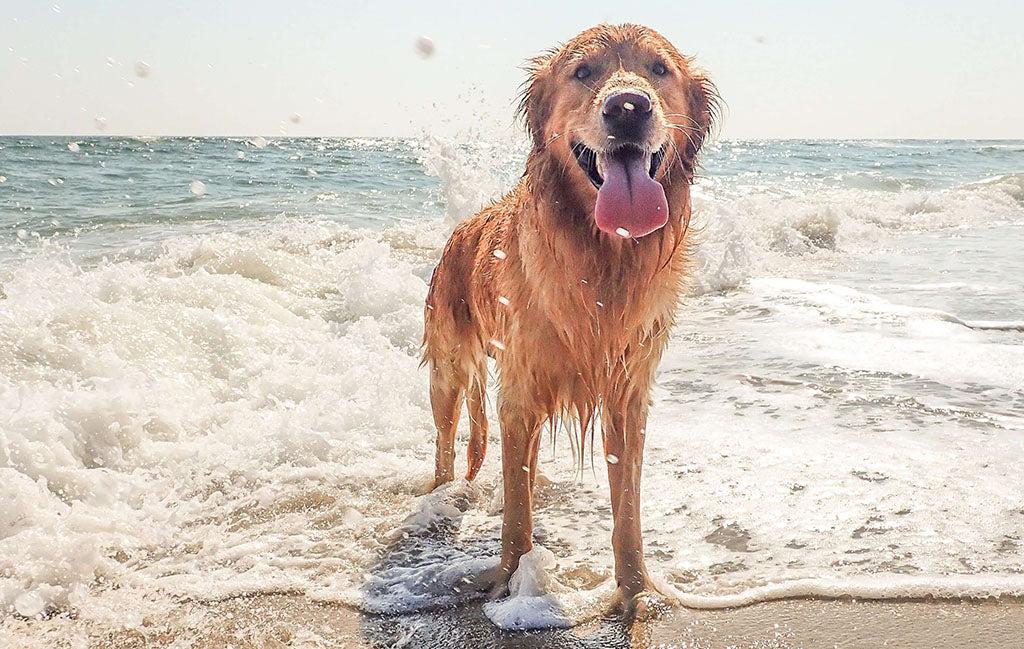How can you distinguish between healthy dog teeth and unhealthy ones? We asked a couple of veterinarians for advice on how dog teeth should look.
- Home/
- Dog/
- Health & Wellness/
- Healthy Dog Teeth: What Do Normal Dog Teeth Look Like?
Healthy Dog Teeth: What Do Normal Dog Teeth Look Like?

Quick takeaway: Normal healthy dog teeth are white or ivory in color and free of yellow or brown buildup. Healthy dog teeth are straight, evenly spaced and whole, with no noticeable cracks or wear. If you are unsure what healthy dog teeth look like, or whether your dog’s teeth are healthy, read on for more information. Remember, it’s important to attend regular dental cleanings with your veterinarian, and to ensure you have a consistent daily doggy dental care plan in place.
What Do Healthy Dog Teeth Look Like?
Dr. Amy Attas explains that dog teeth “should be white or ivory in color and free of yellow or brown buildup at the top which is a sign of plaque or tartar.”
Healthy dog teeth should also be straight, whole, and properly spaced without overcrowding, which is common in smaller breeds. “Crowding can lead to more tartar buildup and infections.”
However, discerning whether your dog’s pearly whites are, in fact, healthy comes down to paying attention to other parts of your dog’s mouth, too.
Your dog’s gums “should be pink and firm, not swollen, and with no visible blood or pus,” says Dr. Attas. She also notes that some dogs have other dark pigments on their gums or tongue (such as Chow Chows) but that doesn’t necessarily indicate problems.
Healthy Dog Teeth Checklist:
Do your dog’s teeth look healthy and normal? They should be:
- White or ivory in color
- Free from yellow or brown buildup (a sign of tartar)
- Straight, whole and properly spaced
- Have pink and firm gums that are not swollen
Healthy Vs. Unhealthy Dog Teeth: A Quick Comparison Chart
A dog’s tooth color and shape, their gum lines, and how the teeth are set can tell owners a lot about your canine’s overall dental health. Here’s a quick overview of what to look for:
| Healthy | Unhealthy | |
| Teeth Color | White or ivory | Noticeable plaque or tartar that is yellowish brown, black, or purple |
| Teeth Alignment | Straight, evenly spaced | Overcrowded, crooked, uneven spacing |
| Tooth Shape | Whole, no noticeable wear | Broken or fractured teeth, uneven wear |
| Tooth Setting | A tight seal around each tooth | Receding or engorged gum lines |
| Gumline | Pink (purple/black for some breeds), firm, moist | Red, swollen, visible blood or pus |
Other Signs of Healthy Teeth and a Healthy Mouth in Dogs
Overall oral health in dogs goes beyond just their teeth—it’s important for pet parents to inspect their dog’s entire mouth to check gums, tongue and overall mouth health.
According to Dr. Kathryn Dench, “a healthy dog’s mouth will have a moist, pink tongue without any sores or discoloration. The roof of their mouth should also be smooth and free from lesions.” There should not be any abnormal growths or masses in the dog’s mouth.
And while some dog owners may think their dog’s breath is naturally stinky, this is actually a strong indicator that there could be an underlying issue. “Their breath should be relatively neutral. Consistently foul-smelling breath can indicate dental disease or other health issues,” says Dr. Dench.
How to Support Healthy Dog Teeth At Home
Cleaning your pup’s teeth prevents more than bad doggy breath. Just like in humans, dental care for dogs is crucial for maintaining their overall health. We brush our teeth every day and go to the dentist for regular checkups and professional cleanings. Why shouldn’t we want the same for our pets?
Keeping up with our own dental health may come as second nature, but, as pet parents, the same thought and effort rarely goes into our dog’s teeth. Healthy dog teeth come with a lot of benefits, aside from minty fresh doggy kisses.
Not only does a healthy mouth “ensure that [your dog] can comfortably eat to receive the proper nutrients in their diet,” says Dr. Chyrle Bonk, but it also prevents bacteria and infections from occurring. “A dog’s mouth is home to a lot of bacteria, which if not kept in check with proper dental care, can travel to other areas of the body, such as the heart, and cause major problems.”
How Can I Keep My Dog’s Teeth Normal and Healthy?
It’s strongly recommended to get your pup used to having their mouth examined and cleaned from the get-go.
- Start by softly petting and handling your dog’s muzzle, rewarding good behavior with a treat for positive reinforcement. In other words, time to check teeth = time for extra treats and pets!
- Once they’re comfortable, gently lift up the lips and examine their teeth. They may be finicky about the back teeth at first, so go slowly and be careful with your fingers. Again, give praise or a treat as you go.
- For cleaning, introduce a dog-specific toothbrush and toothpaste. NEVER use human toothpaste on a dog, since the ingredients can be toxic. Brush in a circular motion, focusing on the gum line. The best results are seen when brushing is done on a regular basis – at least three times per week (daily if possible).

What to Do if You Think Your Dog’s Teeth Might Be Unhealthy
If you notice any changes or problems with your dog’s dental health, it’s important to schedule a call or visit with your veterinarian. They can give you a personalized diagnosis and treatment plan or refer you and your pup to a veterinary dentist if necessary, to ensure your pup has normal healthy dog teeth and a healthy mouth.
Dental care is vital for your dog’s well-being, and it’s never too late to start. With a combination of regular tooth brushing, at-home dental care products, and your vet’s guidance, pet parents can have peace of mind knowing their dog’s teeth are just as healthy as they are shiny.
Conclusion: What Do Healthy Dog teeth Look Like, And How Do I Support My Dog’s Dental Health At Home?
Healthy dog teeth should be straight, evenly spaced, white and free of yellow or brown buildup. You can support your dog’s dental health at home, by maintaining a consistent daily dental care routine, building up to daily toothbrushing, and regularly checking your dog’s mouth for the health of their teeth, gums, and tongue. Remember, you should be taking your dog for regular professional dental cleanings and checking in with your vet if you have any concerns about the health of your dog’s teeth or mouth.
 E
E




